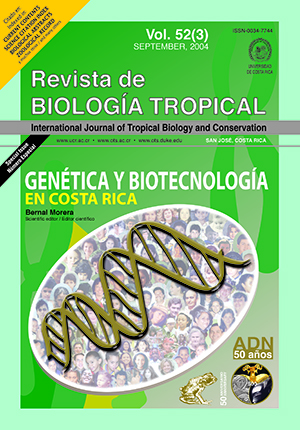Abstract
The non-structural NS3 protein gene from the rice hoja blanca virus (RHBV) was fused to the glutathione- S-transferase carboxilic end and expressed in Escherichia coli strain JM83. Large quantities of fusion protein were produced in insoluble form. The fusion protein was fractionated in SDS-PAGE and purified by electroelution, polyclonal antibodies were raised in rabbit and the antiserum was absorbed with bacterial crude extract. A band of similar size as that of NS3 protein was observed in Western blots using extracts from RHBVinfected rice plants. Immunoelectron microscopy with colloidal gold-labeled antibodies against NS3 protein and the viral nucleocapsid protein revealed in situ accumulation of NS3 protein in the cytoplasm but not in the viral inclusion bodies, vacuoles or chloroplasts of RHBV-infected plants, following the same pattern of distribution as the RHBV nucleocapsid protein.References
Amann, E., J. Brosius & M. Ptashne. 1983. Vectors bearing a hybrid trp-lac promoter useful for regulated expression of cloned genes in Escherichia coli. Gene 25: 167-178.
Citovsky, V. & P. Zambrisky. 1995. Transport of nucleic acids through membrane channels: snaking through small holes. Ann. Rev. Microbiol. 47: 167-197.
de Miranda, J., M. Hernández, R. Hull & A. Espinoza. 1994. Sequence analysis of rice hoja blanca virus RNA-3. J. Gen. Virol. 75: 2127-2132
de Miranda, J., R. Hull & A.M. Espinoza. 1995. Sequence of the PV2 gene of rice hoja blanca tenuivirus RNA- 2. Virus Genes10: 205-209.
de Miranda, J., M. Muñoz, R. Wu & A.M. Espinoza. 1996. Sequence of the Rice hoja blanca tenuivirus RNA-2. Virus Genes 12: 231: 237.
Dean P. 1991. Affinity chromatography: a practical approach. IRL. Oxford. 213 p.
Espinoza, A.M., M. Hernández, R. Pereira, B. Falk & V. Medina. 1992. In situ immunogold labeling analysis of the Rice hoja blanca virus nucleoprotein and major non-capsid protein. Virology 191: 619-127.
Espinoza, A.M., R. Pereira, A., Macaya-Lizano, M. Hernández, M. Goulden & C. Rivera. 1993. Comparative light and electron microscopic analyses of tenuivirus major non-capsid protein (NCP) inclusion bodies in infected plants and of the NCP in vitro. Virology 195: 156-166.
Huiet, L., V. Klaassen, J. Tsai & B. Falk. 1991. Nucleotide sequence and RNA hybridization analyses reveal an ambisense coding strategy for maize stripe virus RNA3. Virology 182: 47-53.
Jennings, P. 1963. Estimating yield loss in rice caused by hoja blanca. Phytopathology 53: 492.
Kakutani, T., Y. Hayano, T. Hayashi & Y. Minobe. 1991. Ambisense segment 3 of rice stripe virus: the first instance of a virus containing two ambisense segments. J. Gen. Virol. 72: 465-468.
Laemmli, U. 1970. Cleavage of structural proteins during the assembly of the head of the bacteriophage T4. Nature 227: 680-685.
Lucas, W. & R. Gilbertson. 1994. Plasmodesmata in relation to viral movement within leaf tissues. Annu. Rev. Phytopathol. 32: 387-411.
Marston, F. 1987. The Purification of eukaryotic polypeptides expressed in Escherichia coli. In D.M. Glover (ed.). DNA cloning: a Practical approach. Volume III. IRL, Oxford.
Nault, L. & E. Ammar. 1989. Leafhopper and planthopper transmission of plant viruses. Annual Review of Entomology 34: 503-529.
Nguyen, M., B. Ramírez, R. Goldbach & A. Haenni. 1997. Characterization of the in vitro activity of the RNAdependent RNA polymerase associated with the ribonucleoproteins of rice hoja blanca tenuivirus. J. Gen. Virol. 71: 2621-2627.
Ramírez, B., G. Macaya, L. Calvert & A. Haenni. 1992. Rice hoja blanca virus genome. Characterization and expression in vitro. J. Gen. Virol. 73: 1457-1464.
Ramírez, B. & A. Haenni. 1994. Molecular biology of tenuiviruses, a remarkable group of plant virases J. Gen. Virol 75: 467-475.
Ramírez, B., I. Lozano, L. Constanino, A. Haenni & L. Calvert. 1993. Complete nucleotide sequence and coding strategy of rice hoja blanca virus RNA-4. J. Gen. Virol. 74: 2463-2468.
Sambrook, J., E. Fritsch & T. Maniatis. 1989. Molecular cloning: a laboratory manual, Cold Spring Harbor Laboratory, vol 3 pp. 17.3-17.42.
Schoumacher, F., C. Erny, A. Verna, T. Godefroy-Colburn & C. Stussi-Garaud. 1992. Nucleic acid binding properties of the alfalfa mosaic virus protein produced in yeast. Virology 188: 896-899.
Smith, D. & L. Corcoran. 1992. Expression and purification of glutathione-S-transferase fusio N-proteins, pp. 16.7.1-16.7.8. In F. Ausubel, R., Brent, R. Kingston, D. Moore, J. Seidman, J. Smith & K. Struhl (eds). Current Protocols in Molecular Biology, vol II. 6th. John Wiley (ed.). New York.
Smith, D., K. Daver, P. Board, W. Tiu, E. García & G. Mitchell. 1986. Mr 26000 antigen of Schistosoma japonicum recognized by resistant WEHI 129/J mice is a parasite Glutatione S-transferase. Proc. Natl. Acad. Sci., U.S.A. 38: 8703-8707.
Smith, D. & K. Johnson. 1988. Single step purification of polypeptides expressed in Escherichia coli as fusions with Glutatione S-transferase. Gene 67: 31-40.
Thomas, C. & A. Maule. 1995. Identification of the cauliflower mosaic virus movement protein RNA-binding domains. Virology 206: 1145-1149.
Toriyama S., M.Takahashi, Y. Sano & T. Shimizu. 1994. Nucleotide sequence of RNA-1, the largest genomic segment of rice stripe virus, the prototype of the tenuiviruses. J. Gen. Virol. 75: 3569-3579.
Volkin, D. & A. Klibanov. 1989. Minimizing protein inactivation, pp. 1-24. In T.E. Creighton (ed.). Protein function: a practical approach. IRL, Oxford University, Oxford, England.
##plugins.facebook.comentarios##

This work is licensed under a Creative Commons Attribution 4.0 International License.
Copyright (c) 2004 Revista de Biología Tropical


